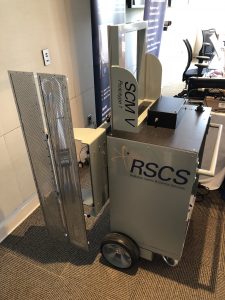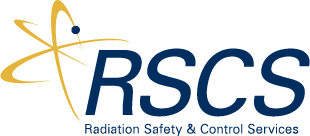 RSCS is showcasing our latest version of the Surface Contamination Monitor, the SCM V, at the Naval Surface Warfare Center Industry Day held in West Bethesda, MD on June 11, 2019.
RSCS is showcasing our latest version of the Surface Contamination Monitor, the SCM V, at the Naval Surface Warfare Center Industry Day held in West Bethesda, MD on June 11, 2019.
The SCM V builds upon the high-performance specifications of earlier versions of this model that have been employed successfully for large area surveys at DOE, DOD and commercial sites since 2000. Based upon a positional sensitive proportional counting (PSPC) detector system that was introduced in the 1990s by Shonka Research Associates, this contamination monitor provides a highly efficient and accurate surveying system to locate and map the distribution of contamination on surfaces.
The SCM’s PSPC detector segments a large area detector into smaller units by measuring the time it takes for a pulse to travel along a biased anode wire. Based on the time differential between the travel time to each counter, the exact location an event occurred along the anode can be determined. The hardware provides for regions of interest that effectively segment the entire anode wire into 5 cm detectors. This detector is coupled to a motorized cart that maintains a fixed geometry from the surface and controls the speed forward to provide a consistent speed of travel forward in 5 cm increments. The data is continually fed to a processing unit that bins the events detected into 25 cm2 pixels. The benefits of this design are that the overall background is reduced to that detected by small detectors while the efficiency is increased to that provided by the larger detection area along the entire length of the anode wire. The resulting system collects 400 measurements per square meter while operating in dynamic mode.
Events detected are continuously logged and then combined into survey reports that graphically display the distribution of counts detected along the travel path. This position correlated data can be used to isolate areas that are below or above an action level. Secondary surveys with the SCM in static mode can be performed to obtain highly accurate cumulative frequency distribution plots.
This latest version of the SCM provides several improvements over prior models, including the use of lightweight materials that allow for easy shipment of the system. The detector height can be adjusted to manage surface irregularities or movement to a different location. In addition, the system now employs two independent motors that are allow for cornering and reverse movement of the cart. The detector design has also been modified to allow for easy replacement of mylar windows in the field. These hardware improvements were coupled to several electronic enhancements, including the use of field programmable gate array chip sets that allow for improved data acquisition for programming and processing, the integration of a robot operating system that provides improved message passing between processors, and a wider signal voltage window that collects more signal pulses and improves the overall efficiency of the system by up to 70% over the previous models.
The SCM V will greatly benefit applications that require the survey of large areas, such as decommissioning sites. Please contact us for additional information on the SCM V and its applicability to your survey projects.
